After years of rumors, pivots, and do-overs, Zwift has finally announced their much-discussed indoor bike. At least, depending on how precisely you define an indoor bike. But no matter which definition you use, this is going to significantly shape the direction of the indoor cycling industry, just as Zwift did when they launched the Zwift Hub nearly two years ago.
The new Zwift Ride combines a new Zwift indoor “frame” with the Wahoo KICKR CORE + Zwift COG trainer, to make a one-stop shop option for getting on Zwift. Within the Zwift Ride product, you can literally see years of Zwift history and direction changes unfolding like layers of rock. It’s actually kinda fascinating.
But more fascinating than the history lesson though, which I’ll save for another day, is riding the thing. And I’ve been doing so for more than a month now, putting it though its paces to see how it handles across a wide variety of riding. Not just me, but my wife as well – helping to validate whether or not Zwift’s one-size-fits-all design can properly accommodate both a tall rider (me), and a vertically challenged rider (her).
As usual, this watch is a media loaner, and it’ll go back to Zwift. After which, I’ll go out and get my own for any future testing needs. If you found this review useful, you can use the links at the bottom, or consider becoming a DCR Supporter which makes the site ad-free, while also getting access to a behind the scenes video series and more! And of course, it makes you awesome.
A Quick Overview:

Before we dive into all the box parts, let’s just quickly go through what this thing is. It’s not complicated, but for those that want the skinny real quick – this chunk of the review will give you everything you need to know. In short, the Zwift Ride takes the previously rumored Zwift Tron Bike concept, and simplifies it. That general concept actually carries through here today, minus the giant glowing wheel set, and overly complex design.
Instead, you’ve got two key components:
A) The Wahoo KICKR CORE ONE smart trainer: This is the same trainer that released a few months back, with one minor tweak. That trainer is a standard Wahoo KICKR CORE, except it’s got the Zwift Cog on it. And in particular, a newer version than what shipped a few months back (the newer version is quieter for this particular chain).
B) The Zwift Frame: This is a single-sized adjustable indoor frame, which has integrated shifters and a variant of built-in Zwift Play buttons and controls functionality. Meaning, it’s got everything Zwift Play has in terms of controls, plus a few more things. Outside of the handlebar button portions, the frame itself though doesn’t have any electronic components. It’s just effectively a bunch of stylish aluminum tubing, with a nifty single-speed chain system (more on that down below).
The two pieces together make ‘Zwift Ride’ (the name of the whole thing). Later this summer, you’ll be able to buy just the Zwift Frame portion, pairing it with existing Zwift Hub smart trainers, and Wahoo KICKR smart trainers. And concurrently, Zwift says other trainer companies are already working to make their trainers compatible with the Zwift Cog (any trainer will work with the Zwift Frame from a physical standpoint, it’s the Cog that needs special firmware on a given trainer.
With that, let’s quickly hit up the key technical specs.
The Key Specs:

First up, let’s look at pricing, inclusive of both the trainer and frame portions (everything you see/need in this post):
USA: $1299.99
EU: €1299.99
UK: £1199.99
Canada: $1,999.99
Australia: $2,299.95
However, there are some additional costs:
Shipping fee: USA – $75, EU – €100, UK – £65
Tablet Holder: USA – $49.99, EU – €49.99, UK – £39.99
Next, we’ve got the two sides to this hardware specs story. One half being the Ziwft Frame, and the other half being the KICKR CORE + Zwift Cog.
Starting on the Zwift Frame side, the specs here are:
– Crank Arm Length: 170mm (non-standard Square Taper)
– Pedals: Flats included, but can swap to any pedal you want
– Q-Factor: 150mm
– Handlebar Width: 420mm
– Handlebar Drop: 125mm
– Handlebar Reach: 70mm
– Handlebar type: 31.8mm
– Rider height: 5’ – 6’6” // 152 – 198 cm
– Saddle Height Min-Max: 61cm-87cm (center bottom bracket to top of saddle)
– Stepover Height: 30 in // 76 cm
– Max Rider Weight: 265 lbs. // 120 kg
– Zwift Frame Weight: 38lbs/17kg
Then transitioning quickly over to the Wahoo KICKR CORE side:
– Flywheel weight: 5.4kg
– Cassette: Zwift Cog (slightly updated)
– Protocols: ANT+ & Bluetooth Smart, both ANT+ FE-C & Bluetooth FTMS
– Max Incline: 16% simulated grade
– Max Resistance: 1,800w
– Claimed Accuracy: +/- 2%
– KICKR CORE weight: 40lbs/18kg
Got all that? Good, let’s get it cracked open.
In the Box:
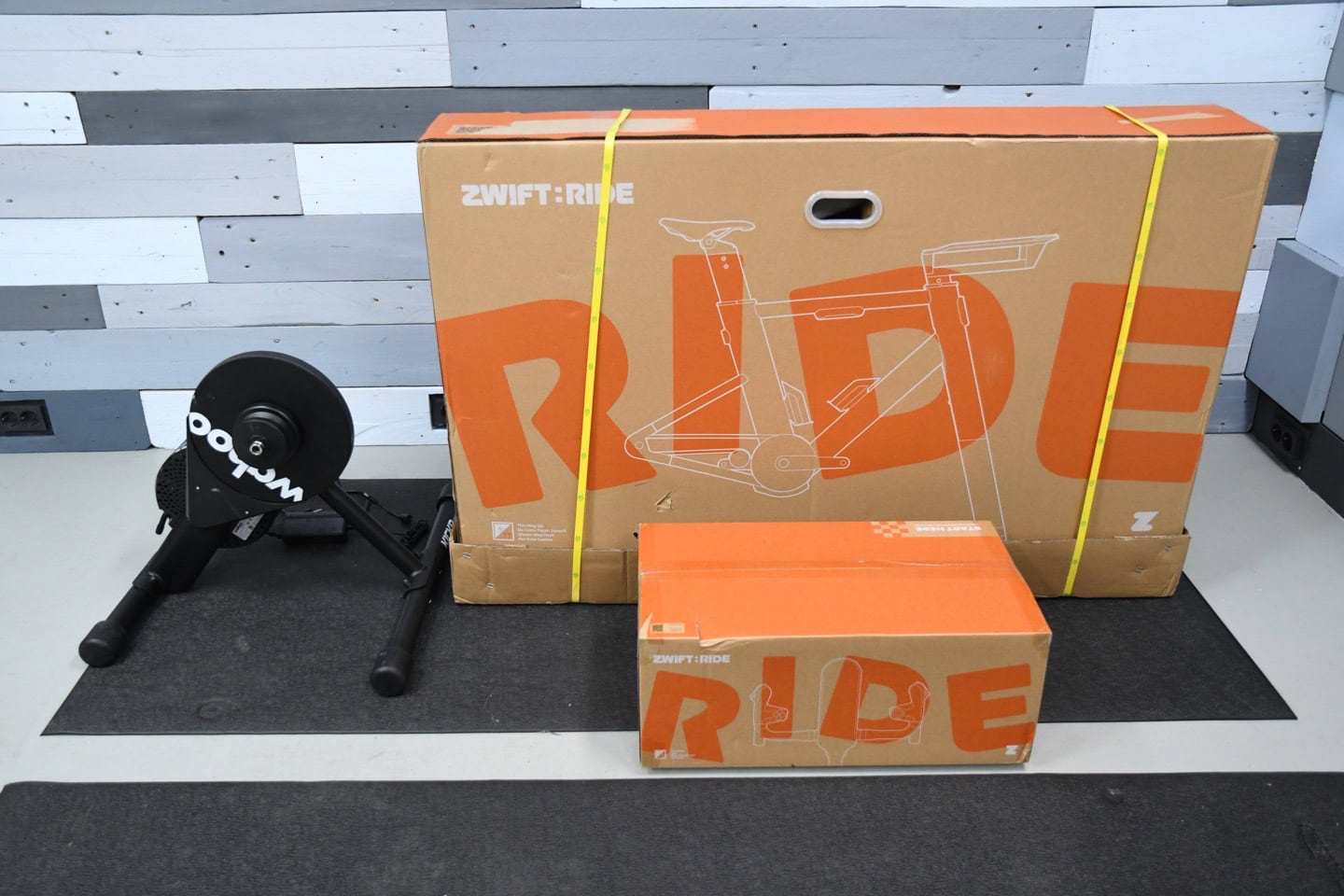
The Zwift Ride essentially comes in 3 boxes. The first is the main Zwift Ride frame, the second is an accessory box for the handlebars & extra components, and the third is the Wahoo KICKR CORE box. In my case, I already had the Wahoo KICKR CORE ONE with Cog, so I just had two boxes to deal with (there was no reason to waste sending another identical KICKR CORE to the one I already had).
Once you unpack everything, you’re left with the following piles of goods. Note in this case, you’ll see a plastic bag in front of the KICKR CORE, that’s actually a slightly updated COG to replace the one I previously had. Thus, if you order a Zwift Frame later this summer/fall, you’ll get that. Whereas if you order the Zwift Ride now, it’ll come pre-installed on your KICKR CORE.
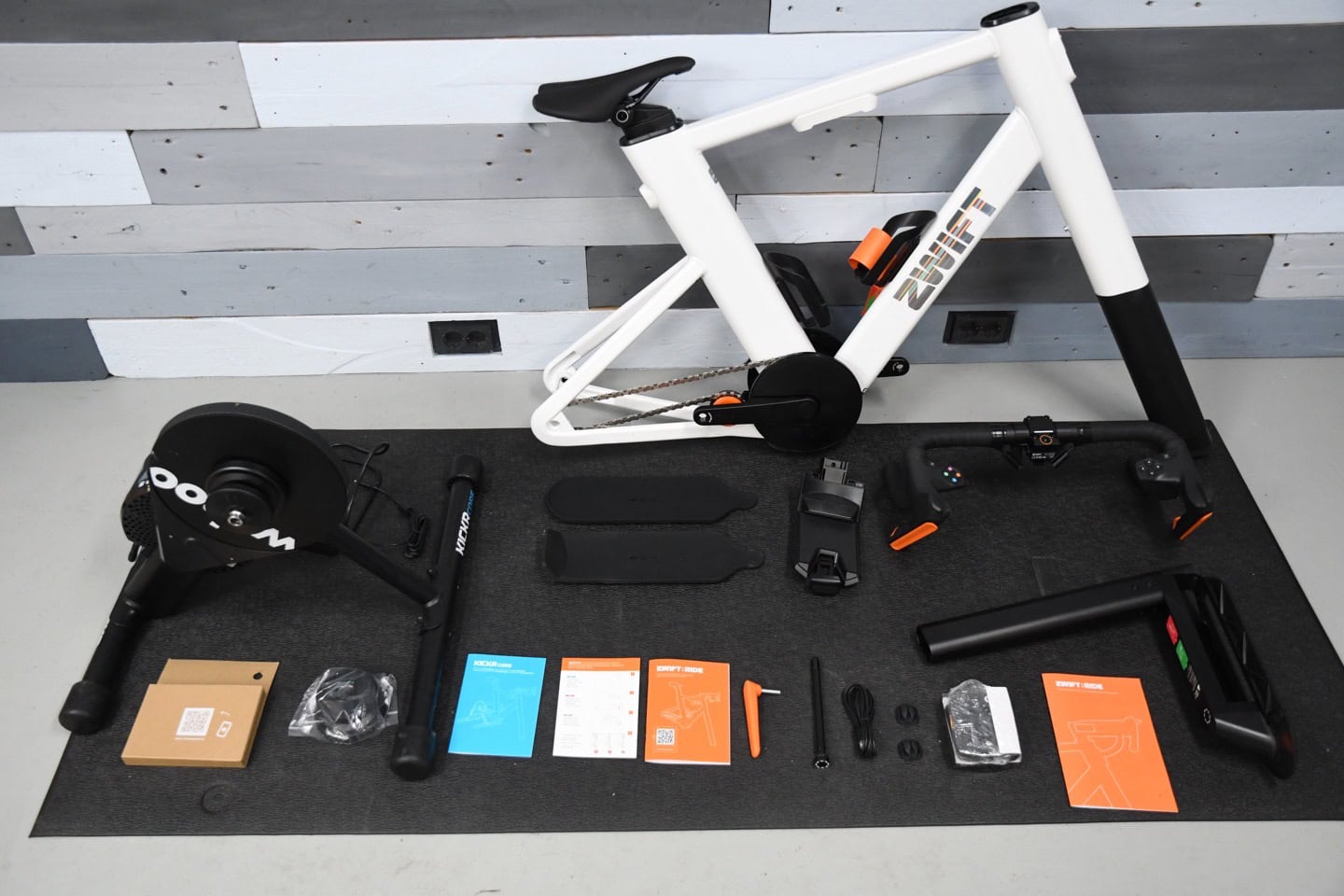
Looking at the piles of stuff, you’ve got instructions booklets for both the KICKR CORE & RIDE frame. These were in the small cardboard holder seen above, which also has a QR code with more guides.
You’ll see the tablet holder included in this bundle (which is a $50 surcharge), as well as two different silicone insets/covers, one for the tablet holder, and one without the tablet holder. There’s a thru-axle adapter and dual-prong USB-C cable.

Meanwhile, for bigger part pieces, you’ve got the handlebar assembly, as well as handlebar post that goes up and down. There’s a pair of flat pedals you probably won’t use, two small magnetic cable holders, and another manual for the handlebar pieces.

Assembly is pretty darn straight forward. You simply drop the frame onto the KICKR CORE like any other bike, then rotate the orange knob you see below upwards, which adds tension to the chain.

From there you’ll add in the seat post and handlebars, which can be adjusted using the orange wrench seen in the background of this photo:

The entire assembly process takes about 5-7 minutes, it’s super efficient. I’ll dive into more tidbits of that in this next section though.
Riding With It:
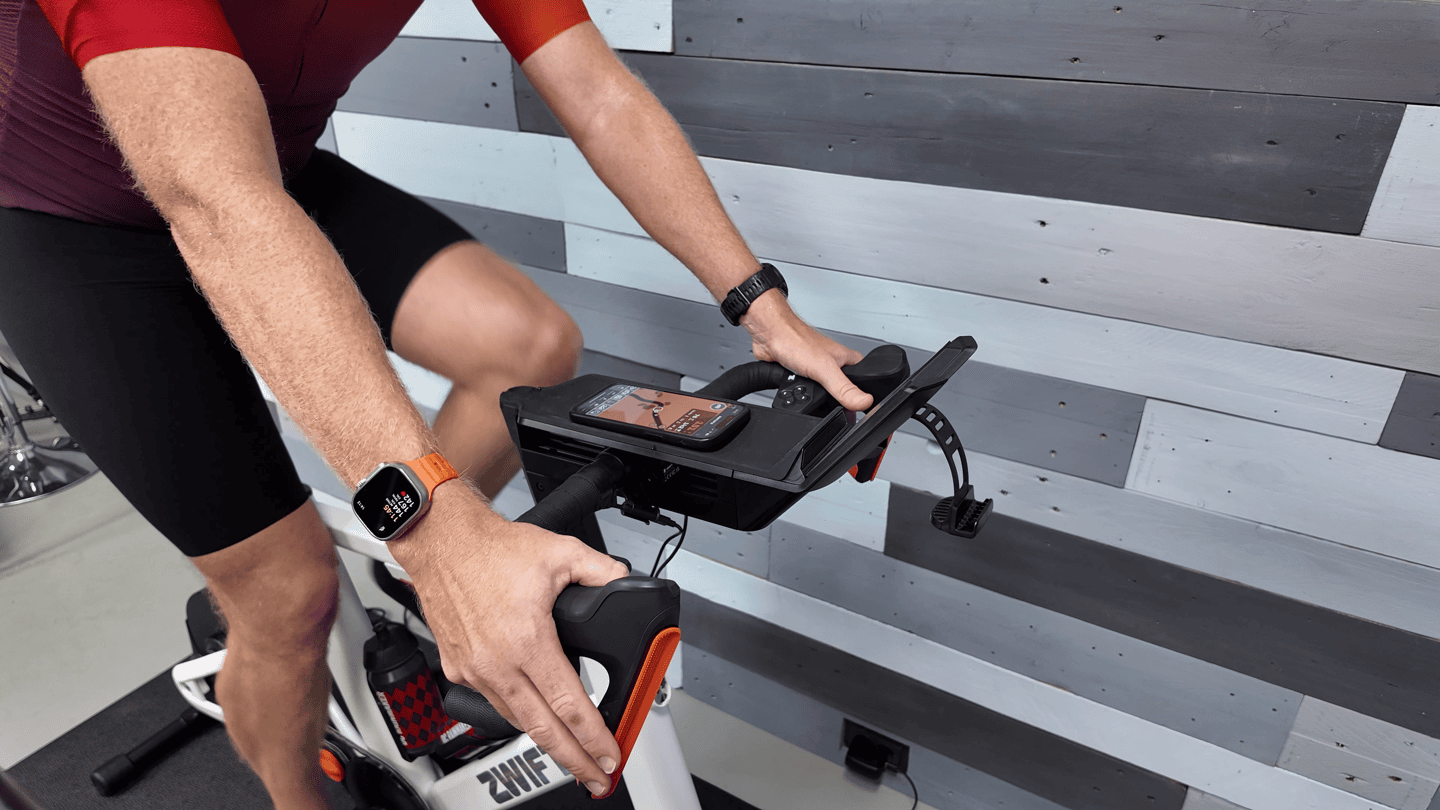
In riding the Zwift Ride over the past month, I’ve often forgotten it’s not a smart bike in the traditional sense of a smart bike. Meaning, it’s technically not one piece – but it acts like all other smart bikes. Maybe we need to change the definition of what a smart bike is. After all, this is effectively a trainer + a frame, just like any other setup. Except in reality, the only difference here is that you can split it into two pieces and has an exposed drivetrain. In almost every other way, it’s a smart bike.
So, first up we’ve got the fit related customization components. How does it fit different rider sizes? In my case, I’m 6’2”/188cm, and my wife is 5’2”/157cm, thus, a pretty healthy spread between us in terms of height. Both of us are able to ride it and adjust it accordingly. In her case, she does most of her training on a dedicated triathlon bike, but we could easily enough add clip-on triathlon bars here if we needed to
The Zwift Ride has adjustability in the following locations:
1) Saddle height (up/down)
2) Saddle position (forward/back/angle of saddle)
3) Handlebar height (up/down)
4) Handlebar position (forward/back)
However, one area you can’t easily adjust is crank length, which is set for 170mm (same as a Peloton Bike or Wattbike). This is a good broad ‘everyone’ option, but isn’t optimal for every rider (I usually ride 175mm). Most other smart bike makers use a bear-claw style design, which allows you to quickly change between 3-5 different crank lengths. But unfortunately, Zwift went with a single size here. That said, for those with enough bike wrench geekery in them, you can technically swap out the crank arms. But again, that’s beyond most people.
 One of the best parts of the Zwift Ride is the hex wrench. Seriously.
One of the best parts of the Zwift Ride is the hex wrench. Seriously.

First off, it’s bright orange and has a dedicated magnet mount on the underside of the frame’s top tube (seen below). This means it always has a home, on the bike, for easy access. Every other company should steal this concept. Second, and most critically: Every single adjustment point uses that single same bolt size. Thus, one wrench to rule them all. It’s super smart.

It’s these little design things that make the difference between a bunch of engineers designing a product, and ones that have been vetted by countless end-user trials, constantly tweaked based on those results. I’ve got a separate post/video diving into that and some of what Zwift did in those areas. Which isn’t to say other companies don’t user test, many do, but as we saw when Zwift introduced the Zwift Hub, the nuance in the initial setup and packaging makes such a difference to newbies when approaching the indoor cycling world.
Next up, there’s the handlebar setup, which of course is adjustable, but atop that is a flat area for placement of your phone. One miss though is that there’s no USB ports here to charge your phone (or, wireless charging). That would have seemed like an obvious one, but Zwift has prioritized design simplicity and price, over USB ports.

If you look closely though, it lists that location as appropriate for bottles, pizza, and donuts.
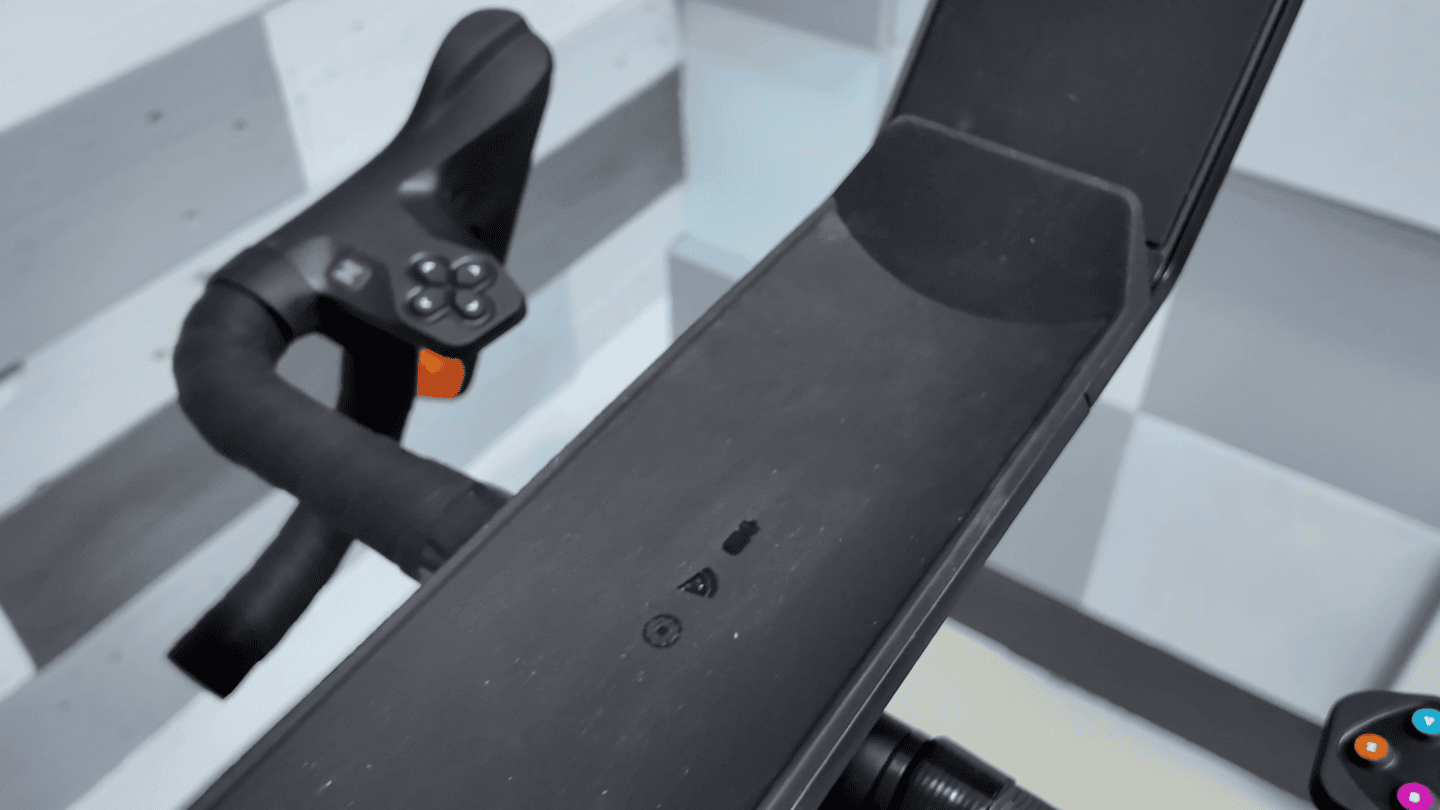
In my case, I tested bottles, phones, and donuts. Sorry pizza, just didn’t work out:

Donuts however, did work out perfectly fine. Be aware though that you should consume the donut in the early portion of your trainer session, to avoid a sweat-filled donut hole. Nobody wants a sweaty hole. Albeit, the Zwift Ride removable silicone tray does have a sweat drainage ditch at the bottom.
Speaking of water bottles, down below you’ve got two water bottle cages. Interestingly, these are ‘open’ pages. Sorta the equivalent of a convertible car. The first time I used the bike some months back, I was concerned the bottles would fall out, but no matter how much rocking-horse I throw at the bike, they haven’t gone anywhere. Frankly, if the bottles fall out, you’re unquestionably on the ground alongside them.

Speaking of which, let’s talk movement and riding, before shifting. Given the weight of this beast, it doesn’t move much. But then again, it’s still half the way of many indoor smart bikes. So while there’s not much give in the system, it was never something that substantially bothered me. If you’re really into rocker plates though, you’ll probably find it a bit stiff. But I’d see no issues sticking this on a rocker plate. As far as sprints and such, I’ve had no stability issues, it’s no different than riding the Wahoo KICKR on a regular bike, except just a bit heavier.

Likewise, there’s no issues with that front peg-leg style design. It actually makes a lot of sense as it simplifies the manufacturing and design compared to a fork design. The bottom cap is removable, so that they can adjust the height down the road for different trainer heights.
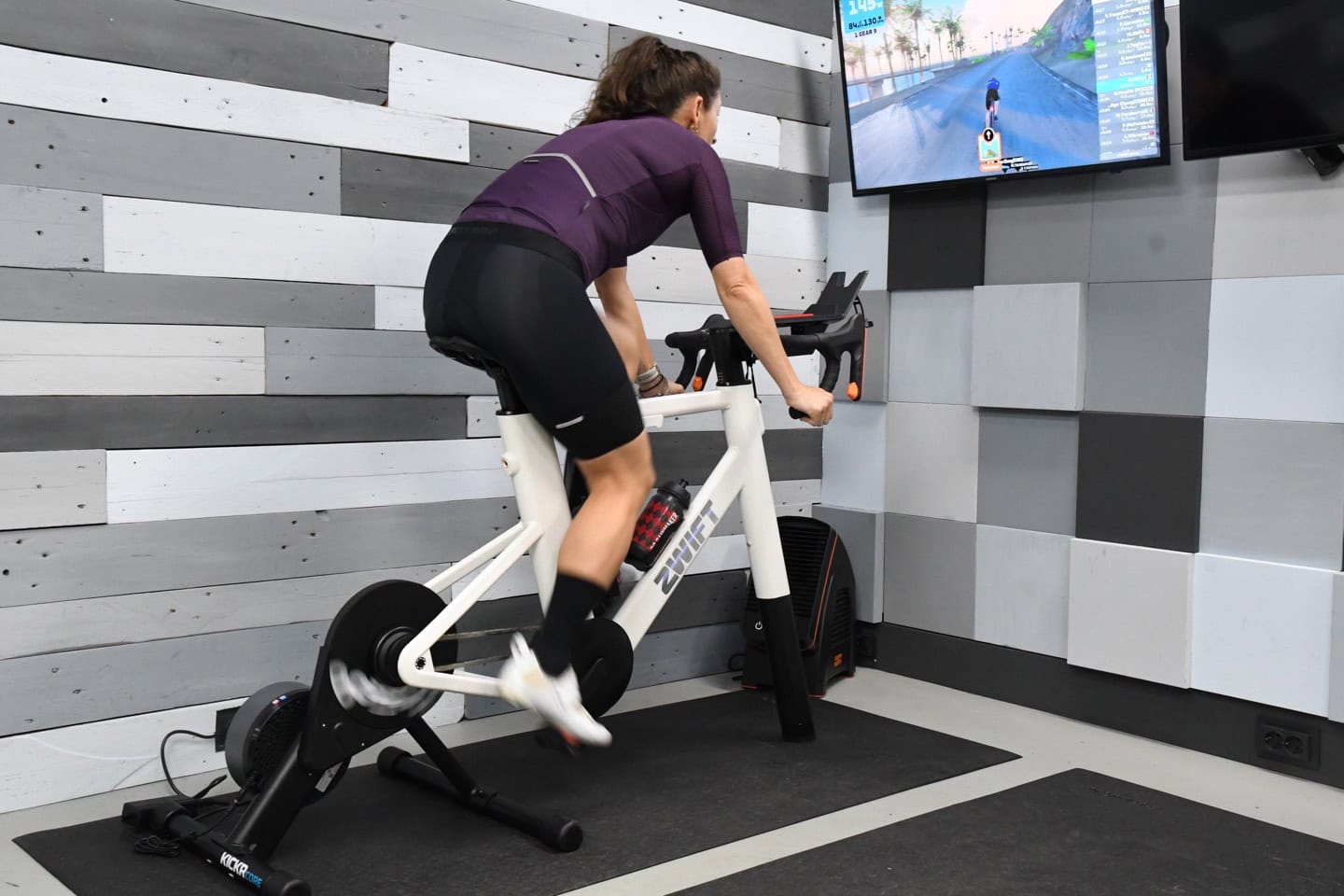
However, it’s not natively compatible with the KICKR CLIMB or Elite RIZER climbing accessories. Zwift says they initially went down that road of trying to add compatibility, but it just increased the cost and complexity for a V1 product too much. But it’s something they’re keenly aware of.
So let’s switch direction and talk shifting and shifters. As noted above, effectively the Zwift Frame has two pieces. The big white frame portion, and then the detachable handlebars. These handlebars have what is effectively a variant of the Zwift Play controllers inside them, but with an extra set of buttons.

On the shifting side, you’ve got buttons on both sides for shifting, both sides for steering, and both sides for braking. Plus another extra Drop button set.

Then, facing you topside, you’ve got two sets of game control buttons – identical to that of the Zwift Play. These control functions in the game, for example giving Ride On’s, confirming selections, or navigating through the quick access menu.

Within this you can choose which route to take at a road junction, control ERG mode, take a screenshot, change your view and more. As anyone whose used Zwift Play knows, these buttons are game changers, and so much better than trying to use the Zwift companion smartphone with sweaty fingers – which usually becomes impossible.

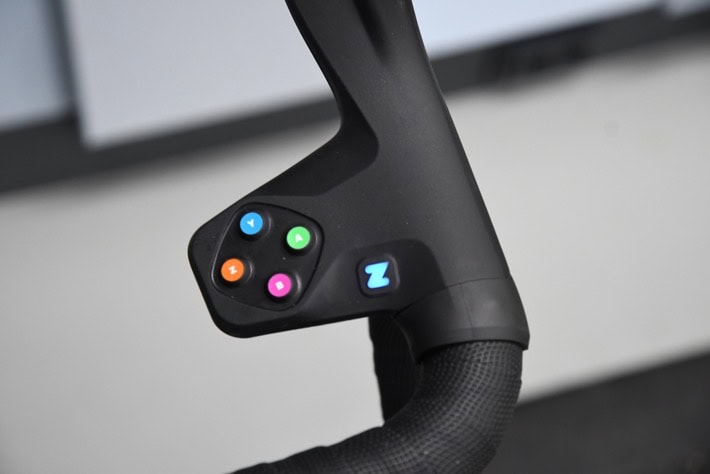
Now when it comes to shifting, you’ve got three different configurations. You can do sequential shifting (which is basically just one series of 20+ gears), SRAM eTAP/AXS style shifting, and Shimano Di2 style-shifting. You’ll choose these in the menu:
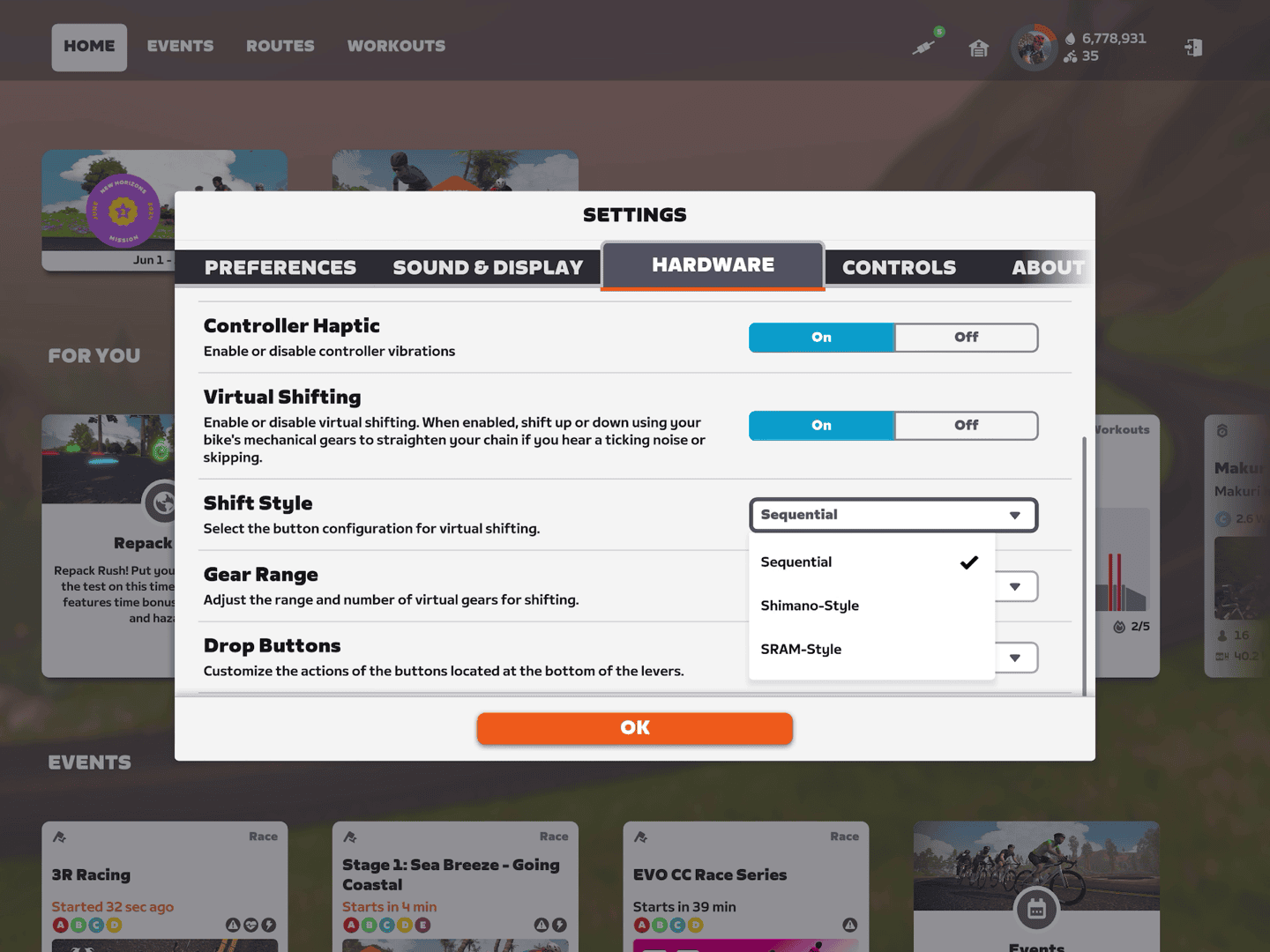
Additionally, you can choose from a few different virtual gear setups below that. You can’t create a completely custom bike like some other smart bikes, but I suspect we’ll see that down the road, as that’s just a minor software update.

From a responsiveness standpoint, I had no issues with the shifters and responsiveness – which was/is just like the Zwift Click+COG combo on the existing Wahoo KICKR HUB ONE and Zwift Hub trainers. It’s all virtually instant. For most of my testing I used either SRAM or Shimano mode, and with all these modes it’ll show you the gearing in the upper left corner:

That said, as good as the button approach is, I still prefer the real-bike-like shifters of the Wahoo KICKR Bike’s, or other indoor smart bikes that have real shifters that actually click. The indoor smart bike industry started off with gamified buttons years ago, but quickly switched to real-bike style shifters, because…you know…realism. Having a game controller just feels, blah, to me. Of course, that’s just my opinion – and I just like the real-world sensation that comes with shifting on an actual bike. However, Zwift says the buttons are more approachable to those newer to the sport.
Switching topics slightly, as far as things like road realism/feel goes, that’s entirely a function of the Wahoo KICKR CORE. When people talk about road feel on trainers, they’re essentially talking about acceleration and deceleration, and how that feels relative to the outside road. I always say – for me personally, it’s hard to separate the fact that I’m riding indoors from outdoors. It’s still a trainer, and I’m still looking at a wall in front of me. My brain can only turn off so much of that. Still, much of the road-like feel is driven by the flywheel, and be it physical or virtual, flywheel sizes tend to be measured in weight. This impacts inertia and how it feels – primarily when you accelerate or otherwise change acceleration (such as briefly coasting).

Starting with road feel, the KICKR CORE has a flywheel weight of 5.4kg, larger than the 4.7kg of the Zwift Hub series. However, unlike some endeavors, size isn’t everything – because flywheel weight is merely one factor – especially because it can be multiplied depending on the exact gearing internally. Nonetheless, this feels good to me. Accelerations are good, decelerations are good, and I’m totally happy with riding it. I’d be totally happy if this was the only trainer/bike I had, in terms of road feel.
Meanwhile, for noise, there’s actually some differences here to a normal KICKR CORE setup. In this case, you’ve got the KICKR CORE itself and the noise it makes (which is none). From there you’ve got the updated Zwift Cog onit, which makes a little bit of noise. Then you’ve got the frame portion, which is is both the chainring and the small orange puck that the chain glides over. Collectively, you will definitely hear the chain. You can hear it in my video, however, as you’ll hear, it’s not obnoxious or super loud – it’s simply sub-fan-level noise.

Lastly, when it comes to connectivity, I do want to briefly mention that the Zwift Ride experience wasn’t great for me with Apple TV. This is because Apple TV has a two Bluetooth connection limit, which means that the trainer takes up one connection, and the Zwift controllers the other connection. That leaves you out of luck for your heart rate sensor, as neither the KICKR CORE (or Zwift controller) pass that through like the older Zwift Hub did. Thus, you’re forced to use the Zwift Companion app for pairing (with Apple TV), and unfortunately, I saw constant drop-outs using that. To the point it simply wasn’t usable for me.

As one who does almost all their Zwifting on Apple TV, this was a bummer. I’d like to see Zwift (or Wahoo) make an effort to get heart rate bridging into their handlebars (or trainers) to sidestep this issue. While Zwift did troubleshoot my issues some, they noted there are a number of cases where this configuration isn’t as reliable as they’d like. I’ll note that I had ZERO issues using my iPhone, iPad, and Mac, to do sessions. This is purely a connectivity reliability issue related to the Zwift Companion App, which, probably won’t come as a great surprise to many (as it has quite the reputation for this sort of thing).
But again, hopefully, that’s something Zwift can invest a bit of time into, to continue making the indoor experience easier.
App Compatibility:

It might seem odd that I include an app compatibility section in a product that’s made by Zwift, for Zwift. But at the end of the day, many consumers use smart trainers with various apps. And at its core, the Zwift Ride is…well…a CORE. Sorta.
This section is nearly identical to that of my Zwift Wahoo KICKR CORE COG review, because, it’s the exact same trainer. The only difference is the controller is a fullest of handlebars, versus a tiny little click of the CORE COG review. But the trainer, and its compatibility (or lack thereof) isn’t any different.
When I first started writing this section on trainers more than a decade ago, the landscape was a minefield of compatibility hell – both on the app and protocols standpoint. However, over the past decade, things have entirely standardized, and I can usually copy/paste most of the specs in this section and tweak slightly as appropriate to the nuances of each unit. At the end of the day, minor capability differences aside, everything worked with everything…until the Zwift Hub One, and now the Zwift Ride. With these units, we’re starting to turn back that clock a bit. Though, there might be some light at the end of the tunnel, more on that in a second.
That’s because while these two trainers are fully compatible from a protocol standpoint with all the ANT+ & Bluetooth Smart standards, the ability for you to shift is very much not. You see, the Zwift Ride will happily broadcast your power/cadence/etc to any app on the planet. And likewise, any app on the planet can also control the Zwift Ride, just like you could do with the previous KICKR Core Hub One. That’s because they properly adhered to all the trainer industry standards. And technically, that’s still true now.
Except, with the Zwift Ride, sending their data *ONLY* to the Zwift app, you can’t shift without the Zwift app involved. And thus, for any indoor trainer app where you want to shift (simulation mode), you’re out of luck with the Zwift Ride. Whereas, for any indoor trainer app in ERG mode (structured workout mode), you’re perfectly fine because you don’t need to shift. Those apps will control the Zwift Ride, just as they always did.

In an ideal world, the Zwift Ride controllers would actually talk directly to the trainer instead. In fact, that’s why we saw Wahoo years ago have the KICKR CLIMB talk instead to the trainer, rather than apps. It ensures compatibility no matter the app. But there are good reasons why it doesn’t, namely because Zwift handles all of the virtual gearing simulation components, rather than offload that to each trainer company.
When I asked about this, Zwift and Wahoo said they’re working to release API documentation that lets 3rd party apps add support for Zwift Play/Click/Ride into their apps. This means that apps like Rouvy or FulGaz or Indievelo could make their apps compatible with the KICKR CORE Cog. However, each time over the last nearly-year I’ve asked for clarification on the date of this, the can gets kicked down the road further – at least for apps. Whereas for indoor trainers, Zwift has actually made progress. You’re going to see other indoor trainer brands in the very near future supporting Zwift Cog, and thus, the Zwift Frame.
With all that said, here’s the complete list of protocol transmission standards/types the Zwift Ride supports, via it’s Wahoo KICKR CORE:
ANT+ FE-C Control: This is for controlling the trainer via ANT+ from apps and head units, and includes power & cadence data. Read tons about it here.
ANT+ Power Meter Profile: This broadcasts as a standard ANT+ power meter, with cadence and speed data baked in.
Bluetooth Smart FTMS: This is the industry standard for apps controlling the trainer via Bluetooth Smart, and includes ANT+ power and cadence baked in.
Bluetooth Smart Power Meter Profile: This broadcasts as a standard BLE power meter with cadence and speed data.
It DOES NOT, however, support these protocols/transmissions (which trainers from Tacx and Elite do support):
ANT+ Speed/Cadence Profile: This broadcasts just your speed and cadence as a standard ANT+ Speed/Cadence combo sensor.
Bluetooth Smart Speed/Cadence Profile: This broadcasts just your speed and cadence as a standard BLE combo Speed/Cadence sensor.
The above two are mostly just useful when pairing to more basic smartwatches that might not support power meters/cadence, but I don’t expect it matters to too many people.
Note that for my testing, I tested within Zwift itself of course, but also did test connectivity to TrainerRoad with an ERG workout without issue, as well as broadcasting to multiple Garmin watches, an Apple Watch, and Garmin bike computer. All recorded the data without issue.
Power Accuracy:
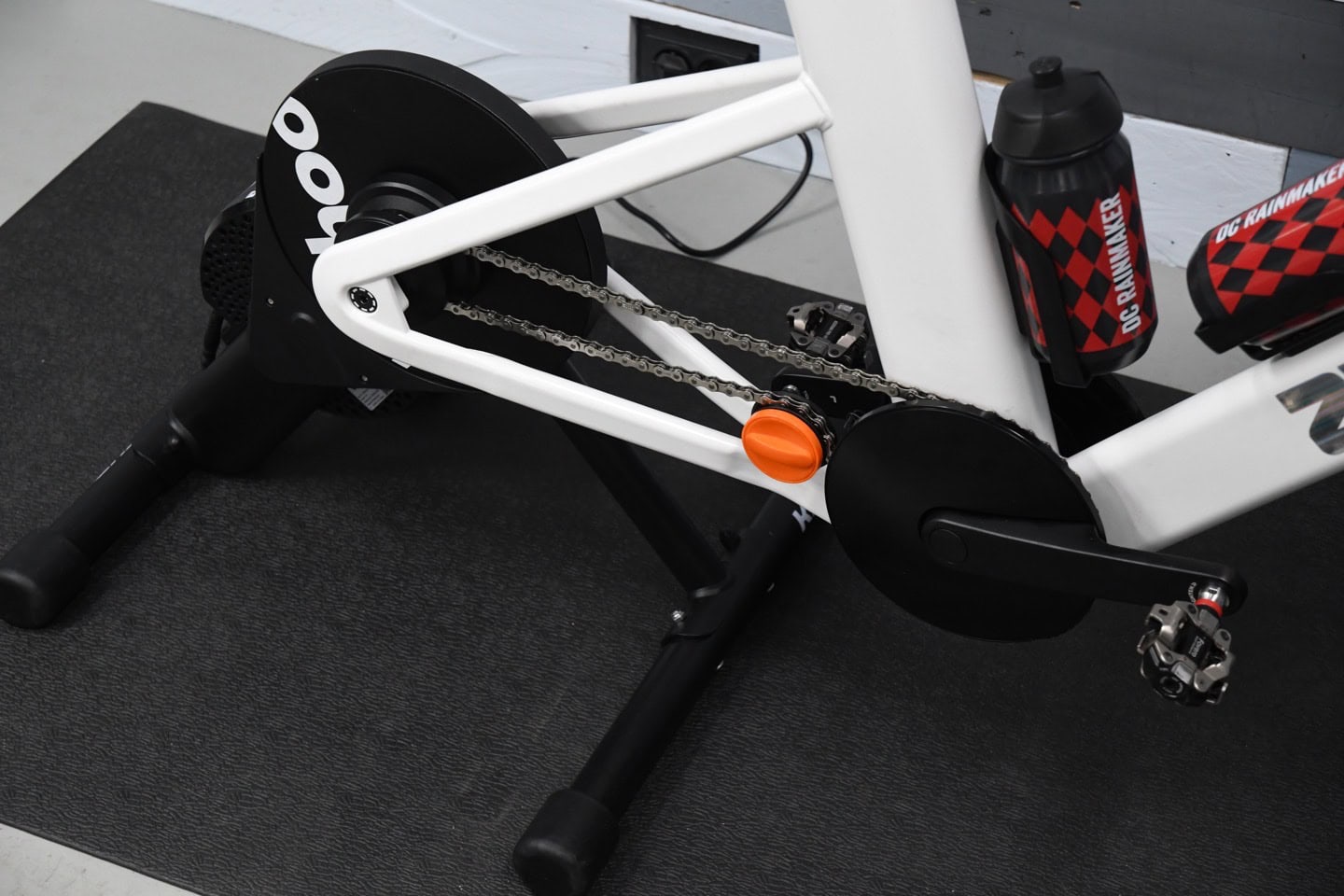
The Zwift Ride is of course actually the KICKR CORE Hub One, the exact same trainer I reviewed just a few months ago. And in my case, literally the exact same unit. Thus, here’s that at a from then, showing everything is perfectly accurate (as it’s frankly been for years). All of my recent rides have also matched that.
You can check out that entire accuracy section, for the exact same trainer I used in this review, here.
Indoor Bike Comparison:
On one hand, it’s not entirely a direct comparison looking at Zwift Ride versus something like a Wahoo KICKR Bike Shift. Yet on the other hand, that’s precisely what most consumers will be looking to do. Thus, I’m going to do it too. Below is a simple table, first comparing the core specs:
| Function/Feature | Zwift Ride | Wahoo KICKR BIKE SHIFT | Tacx NEO Bike Plus | Wattbike ATOM 2020 |
|---|---|---|---|---|
| Copyright DC Rainmaker – Updated June 12th, 2024 @ 6:54 am New Window | ||||
| Price for trainer | $1,299 | $2,999 | $3,999 | $2,599 |
| Trainer Type | Indoor Bike Frameset | Indoor Bike | Indoor Bike | Indoor Bike |
| Available today (for sale) | Yes | Yes | Yes | Yes |
| Availability regions | US/EUR/CAN/AUS/JPN | Limited Initially | Global | UK/South Africa/Australia/Scandinavia/USA |
| Wired or Wireless data transmission/control | Wireless | Wireless | Wireless | Wireless |
| Power cord required | Yes | Yes | No | Yes |
| Flywheel weight | 5.4kg | Simulated/Virtual 125KG | 9.28KG/20.4lbs | |
| Includes cassette | Yes | N/A | N/A | Resistance | Zwift Ride | Wahoo KICKR BIKE SHIFT | Tacx NEO Bike Plus | Wattbike ATOM 2020 |
| Can electronically control resistance (i.e. 200w) | Yes | Yes | Yes | Yes |
| Includes motor to drive speed (simulate downhill) | No | No | Yes | No |
| Maximum wattage capability | 1,800w @ 40KPH | 2,200w @ 40KPH | 2,200w @ 40KPH | 2,500w |
| Maximum simulated hill incline | 16% | 20% (and -15% downhill) | 25% | 25% | Features | Zwift Ride | Wahoo KICKR BIKE SHIFT | Tacx NEO Bike Plus | Wattbike ATOM 2020 |
| Ability to update unit firmware | Yes | Yes | Yes | Yes |
| Measures/Estimates Left/Right Power | No | No | Yes | Yes |
| Can directionally steer trainer (left/right) | Yes | Yes (with compatible apps) | YES (WITH COMPATIBLE APPS) | Yes (with compatible apps) |
| Can simulate road patterns/shaking (i.e. cobblestones) | No | No | Yes | No | Motion | Zwift Ride | Wahoo KICKR BIKE SHIFT | Tacx NEO Bike Plus | Wattbike ATOM 2020 |
| Whole-bike physical gradient simulation | No | No | No | No |
| Can slide forward/back with movement | No | No | No | No |
| Can rock/tilt side to side (significantly) | No | No | No | No | Accuracy | Zwift Ride | Wahoo KICKR BIKE SHIFT | Tacx NEO Bike Plus | Wattbike ATOM 2020 |
| Includes temperature compensation | Yes | Yes | N/A | Yes |
| Supported accuracy level | +/- 2% | +/- 1% | +/- 1% | +/- 2% | Trainer Control | Zwift Ride | Wahoo KICKR BIKE SHIFT | Tacx NEO Bike Plus | Wattbike ATOM 2020 |
| Allows 3rd party trainer control | Yes (but limited to Zwift for shifting) | Yes | Yes | Yes |
| Supports ANT+ FE-C (Trainer Control Standard) | Yes (but limited to Zwift for shifting) | Yes | Yes | Yes |
| Supports Bluetooth Smart FTMS (Trainer Control Standard) | Yes (but limited to Zwift for shifting) | Yes | Yes | Yes |
| WiFi or Ethernet | No | WiFi (Ethernet with accessory) | No | No | Data Broadcast | Zwift Ride | Wahoo KICKR BIKE SHIFT | Tacx NEO Bike Plus | Wattbike ATOM 2020 |
| Transmits power via ANT+ | Yes | Yes | Yes | Yes |
| Transmits power via Bluetooth Smart | Yes | Yes | Yes | Yes |
| Supports Multiple Concurrent Bluetooth connections | Yes, 3 Concurrent | Yes, 3 Concurrent | No, just one | No |
| Transmits cadence data | Yes | Yes | Yes | Yes |
| Bridging or re-transmission | No | No | No | No |
| Race Mode (High Speed Data) | No | No | No | Indoor Bike Features | Zwift Ride | Wahoo KICKR BIKE SHIFT | Tacx NEO Bike Plus | Wattbike ATOM 2020 |
| Shifting type | Button-based controls | Normal bike levers | Normal Bike Levers | Buttons |
| Can customize shifting (Shimano/SRAM/Campagnolo) | Yes (Shimano/SRAM/Sequantial) | Yes (Shimano/SRAM/Campagnolo) | Yes | No |
| Can customize gearing | Very lightly | Yes (both cassette and chainrings) | Yes | Yes |
| Supported Crank Lengths | 170mm | 165/167.5/170/172.5/175mm | 170/172.5/175mm | 170mm |
| Display | No | No | Yes | No |
| USB Ports | No | No | 2 USB Ports (2AMP) | No | Purchase | Zwift Ride | Wahoo KICKR BIKE SHIFT | Tacx NEO Bike Plus | Wattbike ATOM 2020 |
| Amazon | Link | |||
| Backcountry.com | Link | |||
| Competitive Cyclist | Link | Link | DCRainmaker | Zwift Ride | Wahoo KICKR BIKE SHIFT | Tacx NEO Bike Plus | Wattbike ATOM 2020 |
| Review Link | Link | Link | Link | |
Of course, the bigger question is how to compare these from a ride feel/etc standpoint. I think if you’re comparing something like the Zwift Ride to a larger Wahoo KICKR Bike V1/V2, there are obviously more differences with included up/down simulation of the entire bike going up/down, high speed race mode, as well as more flexibility in stand-over height, downhill drive, and more.
However, when you compare it to the Wahoo KICKR BIKE SHIFT, which lacks the up/down piece, things get a bit harder to separate out. Really hard. Still, I’ll make a go of it in an upcoming post, but it’s going to be tough for most people to justify the $3,000 for the KICKR BIKE SHIFT, when this is half the price and does almost the exact same thing.
Wrap-Up:

Every once in a while there’s a product that’s going to significantly change the direction of an industry. Zwift Ride is one of those. At first glance, one might be tempted to write it off as a half-priced smart bike. And sure, that’s true. It does just about everything a smart bike double its price does. In that respect, Zwift has overnight massively slashed the barrier to entry there. But that’s actually not what’s going to change the industry.
What’ll change the industry is the idea of pairing a purpose-built trainer frame, with various trainers. And I say ‘various’, because the reality is that Zwift isn’t just working with Wahoo here. They’re working and nudging/pushing everyone to develop Zwift Frame compatible trainers, via the existing Zwift Cog. By the end of the year, the hardware landscape will be vastly different than it stands today. Heck, even by the end of the summer it’ll be substantially different. By then, you’ll be able to use it with the other Wahoo KICKR trainers, enabling things like higher-speed data rate Race Mode (which isn’t on the KICKR CORE).
Stepping back though, as always, just because something is initially good for consumers doesn’t mean it’s going to be good long-term for consumers. While Zwift is already working with other hardware companies to develop not just Zwift compatible trainers, but also Zwift Play-like integrate smart bikes, one substantial question here is how and when Zwift will open up this connectivity up to other trainer apps. Without that, consumers will be hesitant to buy into a piece of trainer hardware that effectively forever locks them into the Zwift ecosystem. After all, with so many consumers threatening to jump ship to other apps after the recent Zwift price increases, in a Zwift Ride world, you couldn’t do that. You literally couldn’t shift – both on the bike with other apps, and with your wallet to other platforms.
While Zwift has said (repeatedly) they’re open to letting other apps take advantage of this, even making it more of an industry standard, they’ve also sent mixed messages on this too. Until something is actually published that allows other apps to tap into the Cog-based system, you’ll need to consider whether you ever plan to leave the Zwift ecosystem.
Which isn’t to take away from what Zwift has done here. The Zwift Ride is legit very good, and legit very much competes (very strongly) with all the sub-$3,000 smart bikes in the market, and frankly, with some of the $4,000 ones too. Zwift took the time to take their learnings from the so-called never released Zwift Tron bike, into something that’s much better for consumers and Zwift alike. Those years of development are ultimately what gets you this rather polished product, rather than something rushed to market. At the point, the Zwift Ride becomes the defacto smart bike recommendation for almost all riders.
With that, thanks for reading!

